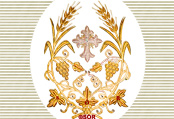
 |
|
||
| Evangelion Damhalte (The Diatessaron) |
|
The form of the Gospel text used by the early Syriac Church is a topic of much debate. The earliest form of the Syriac Gospels of which, however, we are certain is the Diatessaron, a Greek word means 'through [the] four [Gospels]'. This is a harmony of the four Gospels; that is, it is a mixture of the four Gospels in one. It was composed by Tatian, a native theologian of Syria from the middle of the second century. This Diatessaron is known in Syriac as Evangelion Damhalte or 'Gospel of the Mixed'. Its text is, alas, lost. St. Ephrem, the Great Syriac theologian, wrote a commentary on the Diatessaron where he cites many verses from it. Until 1957, even St. Ephrem's commentary was presumed lost until fragments of one manuscript containing the commentary started to appear over the course of almost 30 years, some in the black markets of Paris! No one knows where the manuscript came from, but its authenticity is well established in scholarly circles. The Diatessaron was composed at a time when the notion of canonical Gospels was so young that the composer of the Diatessaron felt free to introduce material not found elsewhere in what we now call canonical Gospels: Matthew 4:4 and Mark 1:6, for example, talk of John the Baptist having lived off 'locusts and wild honey,' which is unusual to an ascetic since locust is a non-vegetarian diet. Tatian felt free to resolve the problem by modifying the text. He substituted 'locusts' with 'milk of the mountains,' the food of the promised land which is mentioned in the Old Testament (Deuteronomy 6.3). The reconstruction of the text of the Diatessaron faces several difficulties. Two issues are to be tackled: What was the actual text? And since it is a mixture of the four Gospels, what is the sequence of verses and from which Gospel was each taken? To help resolve this, one of course must consider translations of the Diatessaron, but then one is faced with manuscripts from the sixth to fifteenth century which originate from as far east as Turfan, in China, and as far west as England. Whether scholars will be able to provide us with an acceptable reconstruction of the Diatessaron remains to be seen. The Syriac Church used the Diatessaron as an authoritative text until the fifth century when it was replaced by the separate Old Syriac Gospels. |
J. Hamlyn Hill, The Earliest Life of Christ: The Diatessaron of Tatian, (Piscataway: Gorgias Press, 2001). |
| Copyright © Syriac Orthodox Resources. All Rights Reserved. |
|
Author: George Kiraz, Ph.D. Last Updated: Feb 25, 2001 |